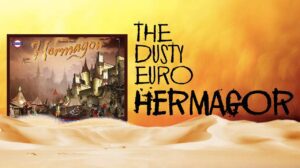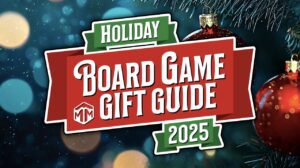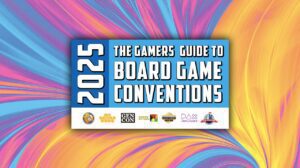Disclosure: Meeple Mountain received a free copy of this product in exchange for an honest, unbiased review. This review is not intended to be an endorsement.
It was only my second turn of my second game, but I could feel my brain beginning to burn.
Ofrenda (2025, Osprey Games) is one heck of a puzzle. In the same week that I was doing my review plays of the Mighty Boards game Tenby, I found myself playing another “this-card-scores-based-on-different-adjacency-rules” game with my family. In Tenby, the complications arise immediately…how do I get this newly-added card to score, if the card next to it doesn’t have the right features to make it trigger and score end-game points?
However, in Tenby, those complications are limited, because cards can only be placed side-by-side. That means that I’m only ever really making decisions on two, maybe three cards on a turn.
Ofrenda, not knowing (or caring) that I was working through these personal problems, pushes the brain in a way that actually might not be fun for some players, despite offering a fascinating puzzle. It makes for a tricky recommendation, because Ofrenda very much feels like a game for a very specific type of gamer. And that gamer wants to feel the brain burn!
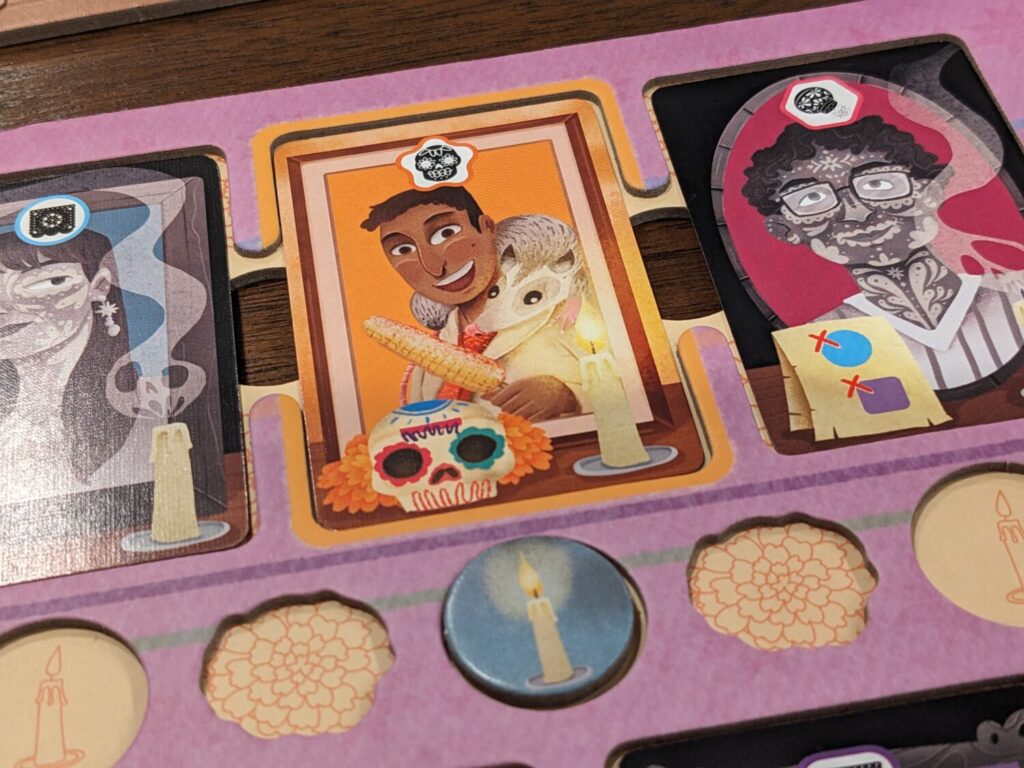
Kneel at the Altar
Ofrenda is a card drafting and placement game for 1-4 players. Inspired by the Mexican tradition of the Day of the Dead (Dios de los Muertos), players get 12 turns to place portraits of recently-deceased loved ones into a three-level tableau to try and score the most points.
Ofrenda sounds a little dark on paper, but the theme melts away nicely when play begins because the illustrations on each portrait card by artist Alex Herrerías very much celebrate life, not death. Each card is double-sided, with a darker side of the cards portraying the deceased character with scoring conditions listed on the bottom left-hand corner. The flip side of the card is revealed once those conditions have been met, which (hopefully!) will lead to a beautiful looking “ofrenda” (altar) by the end of each game.
In practice, that was much harder than it looked. In fact, my first play with my wife was surprisingly bumpy. On a turn, players must draft one card from a four-card tableau into their hand. Combined with three other hand cards (acquired during setup or previous turns), players then must place one of those cards into one of the 12 altar spaces on their board. If placement is a challenge, players can instead discard it to the box to get tokens that are normally used to acquire future cards from the market.
That sounded easy when I first read the rules, but after watching the official teach video for the game, I began to see the future…and that future features very long turns in the wrong hands. Actions in Ofrenda are agonizing, as players need to sort out which card to draft before placement. Cards come in one of five colors, and they also feature five different suits in the top middle of each portrait.
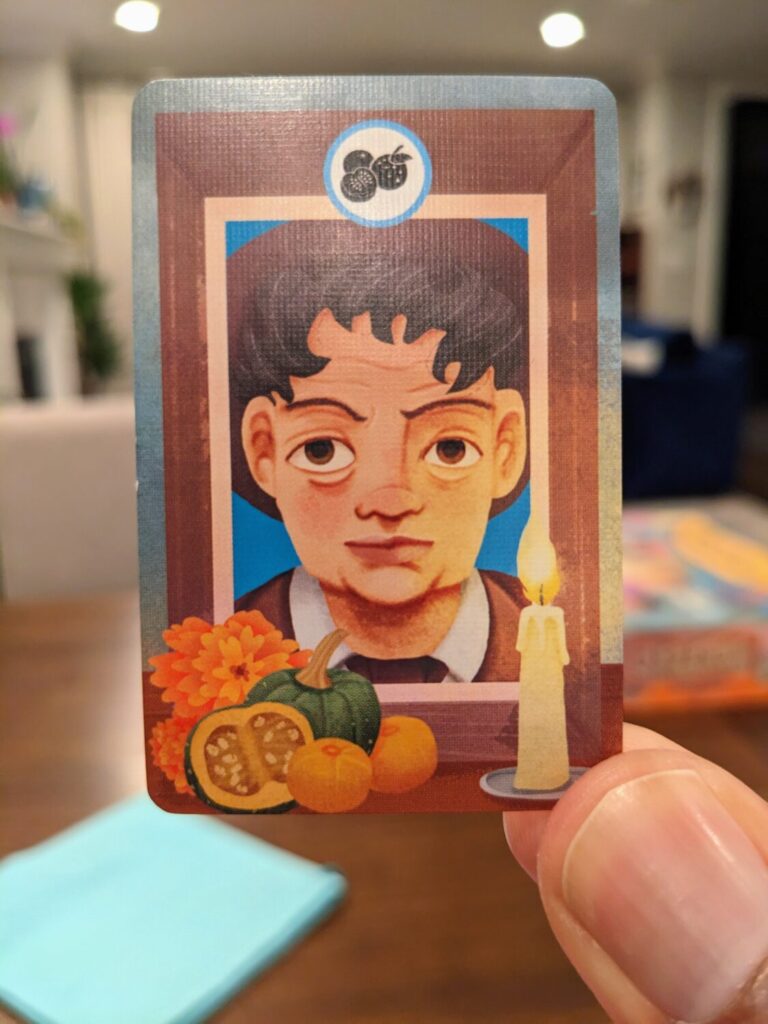
Because card scoring is only tied to portrait adjacency, players struggled mightily to commit cards to certain slots. And because of the way the ofrenda’s grid is laid out, some spots are a little easier to plan for than others. (The game’s one weakness from a production perspective also pops up here—sometimes, the card suit colors are really tough to pick out, because the majority of the card art is often TOO colorful for its own good.)
Let’s say you just placed a card that now has to be surrounded by at least two other purple cards. Great; now, I just have to find two cards to later place adjacent to that first card. But those next cards also have their own rules. One of them might require that all cards next to it have to either feature a skull suit icon, or be green.
So, I’ve got a purple card ready to place next to my first card. But its scoring conditions don’t work for one or two other cards nearby…ack! My hand doesn’t have any cards that are a perfect fit, so maybe I’ll just dump a card over here in the bottom left-hand corner of my ofrenda, and hope I can find other cards later that fit, too.
This is one of the very few games I have played this year that created significant amounts of agony even on the first turn of the game. With two players, my first game of Ofrenda took 45 minutes, which feels long for a 12-turn game with such a simple ruleset. That might mean your first game of Ofrenda at the full player count might be a 90+ minute slog.

The Puzzle is the Puzzle
Ofrenda’s central puzzle is very interesting; after that first play with my wife, I ran the game back immediately as a solo play, using a very simple automa that removes certain cards before each of the solo player’s turns. That second play only took about 20 minutes but it featured a similarly-massive number of decisions as I plotted a way to try and match the high score ceiling of 110+ points.
But I didn’t even come close, scoring 58 points in that second play after scoring 75 points in my first. Ofrenda then posed a different question for me: is the card draw going to be perfect enough for me to accomplish something beautiful here? Or will I likely end plays in that 60-80 point range because it is so difficult?
Ofrenda feels like an abstract that will land best with players who are looking to stare at the board for hours to find the perfect way to score their board. I know a few people like that, and Ofrenda is very likely going to shine for them in ways that it did not for me. (And, I haven’t even covered the way the game scores, or the way candle and marigold tokens work…none of it. Just worrying about how to score the portrait cards feels like a much more serious puzzle.)
Opinions from other players really ran the gamut. I did a solo play, the two-player game with my wife, and a four-player game with my review crew. My wife won’t be coming back. One of the guys in the review crew loved it and was excited to try the solo version to see if he could solve the riddle. Another guy was lukewarm on the first play but thought his opinion would rise once he tried it a second or third time. Another guy hated it…and scored less than 40 points, which the solo high score chart indicates is a “you are terrible at this game”, bottom-feeder result. (The actual text, for anyone who scores less than 70 points: “Oh dear, what a mess! You’ll need a lot of practice before the next Dia de los Muertos.”)
As a production, Ofrenda is glorious…just like every other Osprey game I have played. Whether I liked the game or not, I always land in the same place—Osprey gets that games are sexy toys, and I want those sexy toys. Beyond the brilliant art from Herrerías, Ofrenda’s player boards are the altar displays where cards are stored, and they are nice and sturdy. The rulebook is tidy. There’s a small board included to display portrait cards, and there are cloth bags included to hold the marigold and candle tiles, a nice and honestly unnecessary touch that adds class to the entire affair.
As a design, Ofrenda is fine, but I know that it is not a game that excites me as much as it frustrates me. Add Ofrenda to your collection if this sounds like the kind of puzzle you and maybe a partner can appreciate in a way that will force it to the table for repeated plays. Designers Orlando Sá and André Santos (the men behind Neotopia) have helped produce another looker, and one can tell they have at least a passing interest in the subject matter. It was a pleasure attempting to honor those we have lost, but I wish the game brought me more joy during my time with it.



